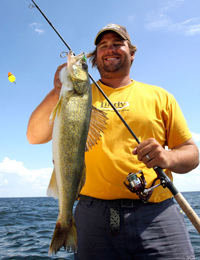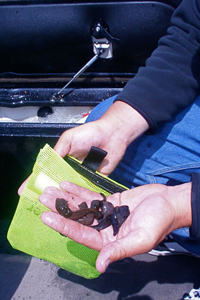|
Wobble Bobbin’ Walleyes - by Daniel Quade |
Wobble Bobbin’ Walleyes - by Daniel Quade Complex presentations get plenty of press these days, but few walleye tactics are as deadly—or as easy to fish—as the simple slip-bobber rig. With a well-balanced float, you can efficiently and precisely suspend mouthwatering live bait in front of hungry ’eyes. Plus, you know exactly when a fish has inhaled your bait. Veteran guide Mike Christensen is a believer. Big time. From his home base out of historic Hunter Winfield’s Resort on the scenic south shores of Minnesota’s mighty Mille Lacs Lake, the jovial yet dead-serious walleye hunter launches literally hundreds of missions onto the fabled fishery with one goal in mind: connect clients with the big lake’s walleye bounty. His success rate is epic, and one of his favorite presentations throughout much of the season is, you guessed it, a slip-float rig. When wind whips the surface, a Thill Pro Series Slip Float rules the waves. He favors the size XXL version, a 1-incher that’s easy to see bobbing amidst the whitecaps. But when the wind dies and surface flattens, he deploys a new secret weapon that livens up his bait in spite of the lull—Thill’s Wobble Bobber. Fresh on the walleye scene this season, the pear-shaped float rocks back and forth with the slightest ripple or twitch of the rodtip. “It’s ideal for calmer conditions,” he says. “If it’s absolutely dead flat, you can impart action to your bait just by shaking the rod.” Thanks to an aerodynamic profile and slick internal weighting system, the Wobble Bobber also grabs serious air when slung from standard spinning tackle. Such long-casting properties are perfect for keeping your distance when targeting nervous ’eyes roaming the shallows. Long casts also make it easy to thoroughly cover a reef or other structure from an anchored position—without moving the boat—and are a huge plus for the shore patrol. Christensen says the Wobble Bobber is lethal for skinny water walleyes that are patrolling weeds, shallow rockpiles and boulders, or holding on the edge of steep breaks. “I use it in deep water situations as well,” he adds. When it comes to the deep game, one of the classics is a pattern Christensen and fellow Mille Lacs guide Jon Thelen fondly call “road hunting.” At its core, the tactic involves cruising the tops and slow-tapering edges of promising reefs, mud flats, gravel bars and other promising areas at slow speeds, watching the sonar for signs of active fish hovering a foot or so off bottom. “These are the biters,” says Christensen. “Bottom-huggers may eat if you park on top of them and wait it out, but we’d rather catch five aggressive walleyes in the time it takes to coax one less-active fish into eating.” Proper sonar settings are crucial to distinguishing walleyes from clouds of baitfish or insects, as well as smaller fish such as perch. “I set the chart speed, sensitivity and color on my Humminbird sonar so suspended walleyes are identified by yellow highlights inside the arc,” Thelen explains. “On bottom, low-riding fish will have a bluish halo on the sides, while rocks won’t.” Whether it’s calm or windy, Christensen likes the Wobble Bobber for road hunting because of its ability to deploy 20 to 30 feet of line more quickly than many conventional floats. “It has brass grommets at both ends, so line slides through it fast,” he says. “This is important with this presentation, because you want the bait in the strike zone before an aggressive fish moves off or settles back to bottom.” His standard road-hunting rig includes a 7½- to 8½-foot spinning outfit. “A rod with a long, sensitive tip is key to good hooksets,” he says, explaining that when a fish pulls the float under water, the limber tip lets you reel up slack until you feel the weight of the fish on the line. “Otherwise, anglers have a tendency to set too soon. And when you try setting the hook before getting all the slack out of the line, you miss the fish.” Christensen spools with 8-pound green monofilament mainline. After threading on an adjustable bobber stop, he slides on the Wobble Bobber and then ties a swivel to the business end, followed by a four-foot length of the same line. (Note: Christensen says that doubling the line makes it easier to thread through the Wobble Bobber.) A split shot large enough to balance the bobber is pinched on a foot or so beneath the swivel. “This reduces the chances of the rig tangling on the cast or the drop,” he notes. Another 24 to 30 inches below the shot, he adds a 1/32-ounce Lindy Jig. The leadhead sports a sturdy hook that’s large enough to hold a jumbo leech or half ‘crawler, yet is light enough to rise and fall seductively with the waves, or action imparted by the bobber. Jigs also offer a more lifelike profile than plain hooks, he adds. “Hooks hang vertical, but I want a horizontal profile, which mimics the natural look of swimming prey,” he explains. While leeches are Christensen’s go-to bait, nightcrawlers often get the nod during bug hatches. “Hook them through the nose and pinch the crawler off halfway down,” he says. To set the stop, he clips a Thill depth finder to the jig and drops it to bottom. “Set the bobber stop so the jig rides a foot above the fish—not a foot above the bottom,” he continues. “This is important, because active fish are looking up, and they’re far more likely to move up to hit the bait than they are to move down.” Rigged and ready, Christensen idles over flat-topped feeding structures and gradually tapering edges along their sides. “Steep drops are tough to road hunt, because you have to change the depth of the jig,” he says. Once a fish is marked, he flips the float directly behind the boat’s transom and pays out line so the jig can quickly reach the fish. “Let the boat drift away, to avoid spooking the fish,” he adds. “If it’s calm, twitch the cork to give the jig a little action.” If nothing happens within a few minutes, Christensen reels in and moves on. “If they’re going to hit, they do it pretty fast,” he says. “On a good day, about one out of two to three drops results in a fish, so don’t waste time if the fish moves away or decides it’s not in the mood.” |
|
| See More Fishing Articles, Fishing Reports and Fishing Videos click >> Fishing Archives Section . | |


